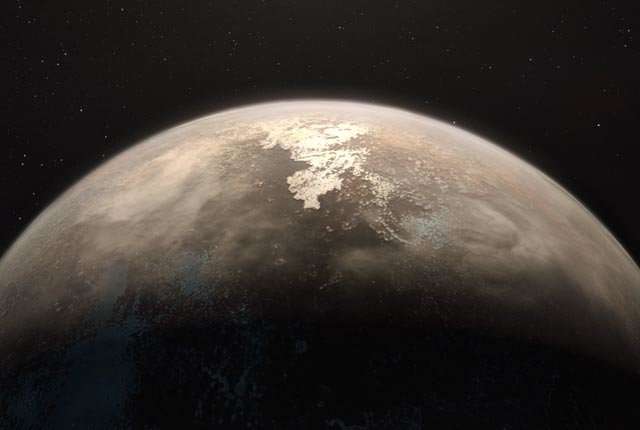An artist’s impression of Ross 128 b, a temperate, rocky planet about 11 light-years from Earth that could have the necessary conditions for maintaining liquid surface water. Credit: European Southern Observatory/M. Kornmesser
Scientists looking for life on distant planets are making plans to search non-Earth-like planets based on discoveries within our solar system that are challenging long-standing ideas about habitable zones, plate tectonics and more.
In a new paper published online this week, Rice University geophysicist Adrian Lenardic and more than a dozen co-authors outline a path for both finding potential life signs around other stars and determining how likely it is that those signs are caused by alien life. The paper, "Exoplanet Biosignatures: Future Directions," is available online and due to be published in Astrobiology.
Lenardic, who specializes in studying planetary dynamics, also authored an associated paper, "Volcanic-Tectonic Modes and Planetary Life Potential," that will be published as a chapter in the upcoming "Handbook of Exoplanets" from Springer Publishing.
"It used to be the thought that life could only exist in a narrow zone near a planet's star because you need to be there to maintain liquid water," said Lenardic, professor of Earth, environmental and planetary sciences. "Then, we send Voyager out to a moon of Jupiter and, lo and behold, it shows strong indications of a subsurface ocean. That's because there is another energy source that did not get its proper due—tidal forces from the intense gravitational pull of Jupiter.
"This has opened up the range over our own solar system in which life can exist, and I think a lot of the gist of the forthcoming papers is that much of what we're seeing is expanding the zone and expanding our thinking about the conditions needed for life. So, as we look for life around other stars, we should also expand our search strategies or we might miss something."
Astronomers have cataloged more than 3,700 planets around distant stars. The 21-foot diameter mirror on the James Webb Space Telescope, which is set to launch in 2019, will be able to examine the atmospheres of rocky planets around distant stars, and astronomers are already designing future missions and instruments that will look for specific atmospheric signatures of life.
"A goal was to frame the problem," Lenardic said of the new biosignature paper, which sprang from an exoplanet workshop that brought together a range of scientists. "The workshop team wanted to come up with a means of assigning a likelihood of life based on a given set of observations of a distant planet."
He said the search for exolife is a team sport that involves biologists, astronomers, planetary scientists and others who collaborate through groups such as NASA's Nexus for Exoplanet System Science (NExSS) project and the European Space Agency's International Summer School in Astrobiology.
Lenardic's contribution is to examine how the internal energy of planets, and associated volcanic-tectonic activity, influence their climate and ability to sustain life.
"When I teach planetary science, one question I actually give students is, 'What is life? Give me a definition.' And it's not easy," Lenardic said. He noted that students and working scientists have put forward a range of answers.
"But if we can agree on one thing, it's that life needs energy," he said. "We've thought about the sun as an energy source for a long time, and we've come to appreciate a planet's internal energy, which comes from decay of radioactive elements within its rocky interior. Jupiter's moons have taught us to also appreciate tidal forcing, and we're starting to find exoplanets that have orbits that allow for significant tidal forcing."
Lenardic said plate tectonics, much like the narrow habitable zone, is another long-held criterion for planetary habitability that is being challenged by recent findings.
Plate tectonics is the large-scale process that governs the movements of Earth's crust.
"It is a particular surface manifestation of a planet's internal energy, but it is not the only possible mode of volcanic and tectonic activity on a planet," Lenardic said.
On Earth, plate tectonics plays a role in modulating climate, but the idea that plate tectonics is crucial for life is challenged by increasingly sophisticated models of planetary climates. For example, in a January study in the Journal of Geophysical Research, Lenardic and colleagues showed how water could be maintained on worlds without plate tectonics. The chapter in the upcoming "Handbook of Exoplanets" further explores this idea by considering planetary life potential under a range of tectonic modes that differ from Earth's.
"I'm an optimist," Lenardic said. "We're at the first point in our history as humans where we might actually have some observations from other planets that we can use to test any of these ideas about life beyond our own. It can be easy to be Earth-centric and assume that life requires a planet like our own. But what we are seeing within our solar system is causing us to question this. One of the things I have learned from the history of exploring our own solar system is to be prepared for surprise. As we move beyond our solar system, in our search for life, that lesson is driving us to adapt our search strategies."
More information: Exoplanet Biosignatures: Future Directions. arxiv.org/ftp/arxiv/papers/1705/1705.08071.pdf
Volcanic-Tectonic Modes and Planetary Life Potential. www.researchgate.net/publicati … etary_Life_Potential
Journal information: Astrobiology , Journal of Geophysical Research
Provided by Rice University






















